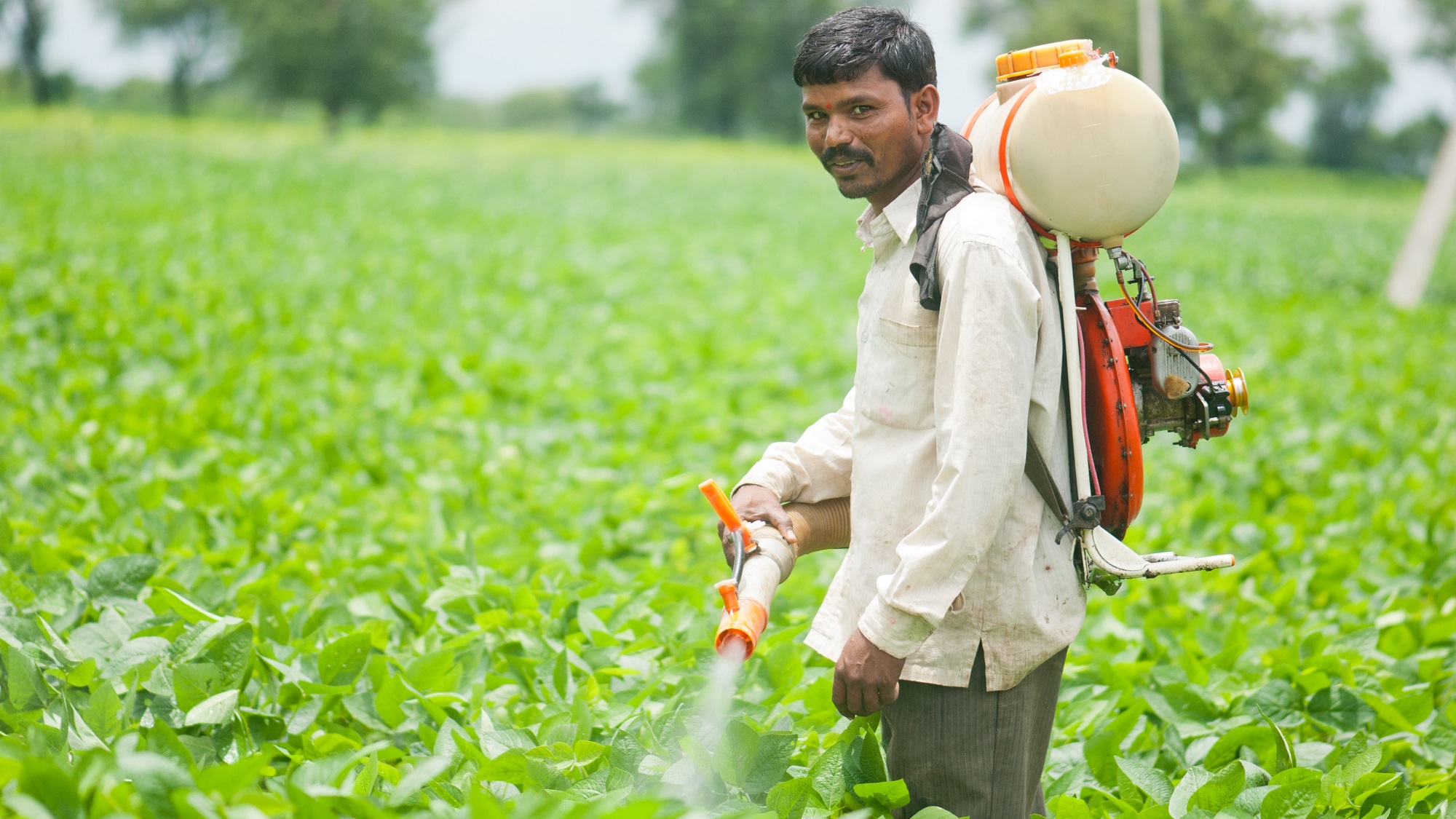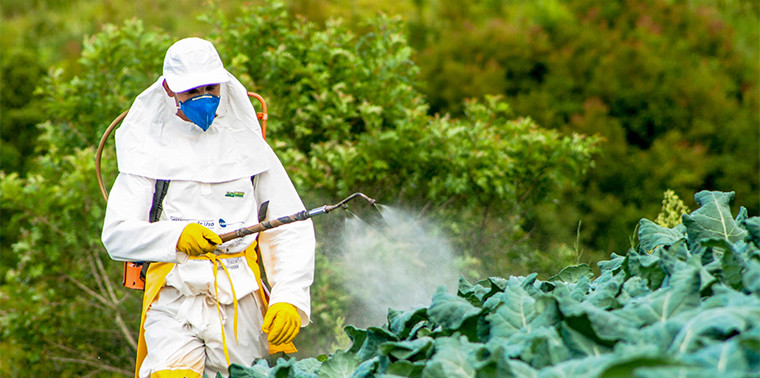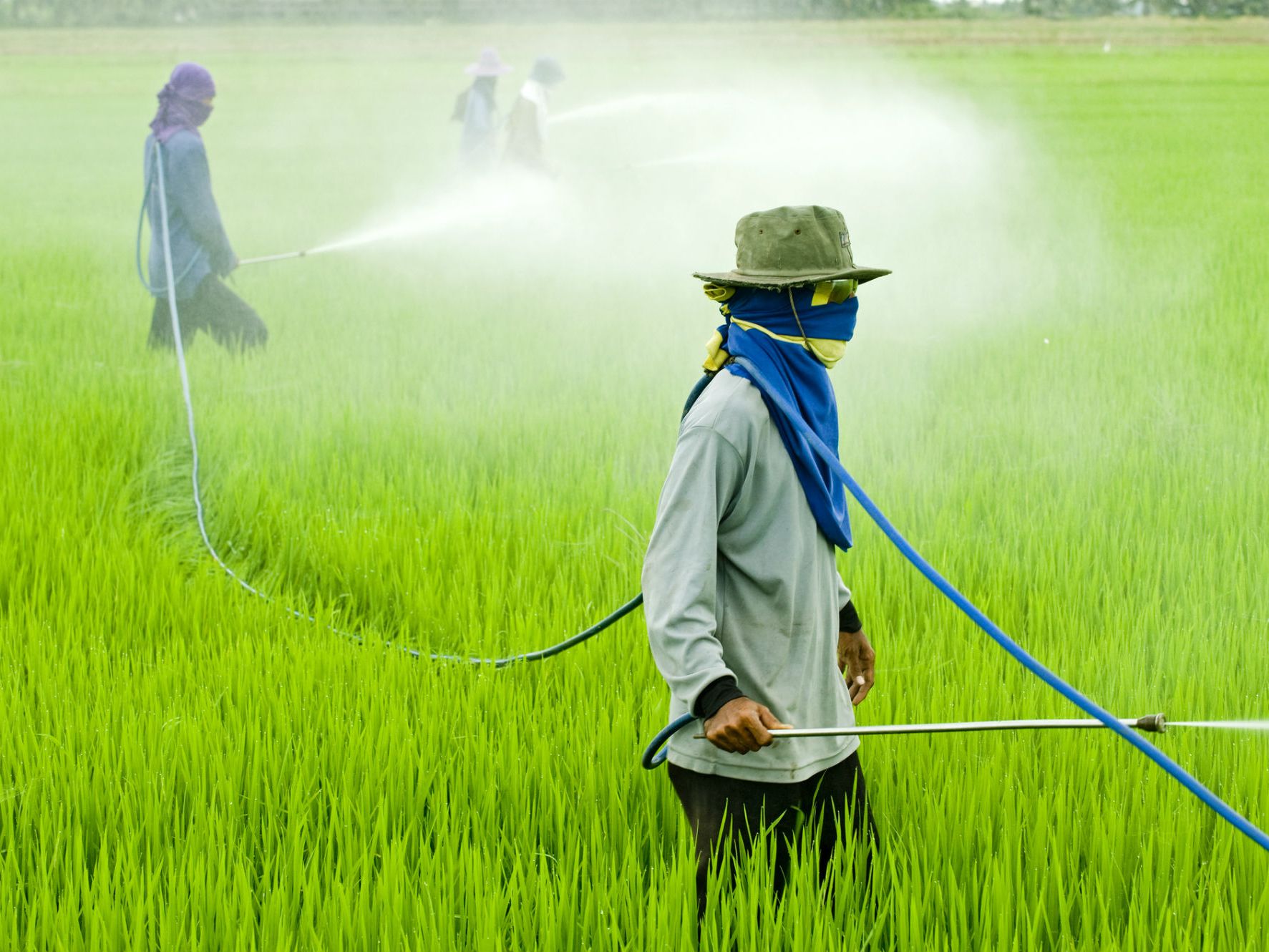Pesticides are poisons and, unfortunately, they can harm more than just the “pests” at which they are targeted. They are toxic, and exposure to pesticides can cause a number of health effects. They are linked to a range of serious illnesses and diseases from respiratory problems to cancer.
Exposure to pesticides can occur in many ways. Farmers and farm workers can be exposed to pesticides in agriculture through the treatment of crops, plants and grain stores. Rural residents living next door to farms can be exposed to pesticide drift. Exposure can also occur in forestry, professional and domestic pest control, through the treatment of wood with preservatives, the treatment of boat hulls with anti-fouling agents, and the treatment of livestock with anti-parasitic preparations, e.g. sheep dip. In our towns and cities we are exposed to pesticides through the spraying of amenities, such as our parks, pavements and playgrounds. Many people buy pesticides off the shelf for home and garden use. And finally, pesticide residues found on, and in, our food also puts us at risk.
What are pesticides?
A pesticide is a substance used to kill feral animals, insects, fungi or plants. There are thousands of different pesticides in use today. Pesticides are used in houses, shops, offices, storerooms, sheds, gardens, farms, pastoral stations and many other places.
Most of the pesticides used today are chemicals which have been developed in a laboratory by scientists and produced in factories. Some pesticides are quite hazardous, as they can be harmful to humans and other living things.
They can contaminate land, the air, food crops, water ways and seriously harm or kill native animals, pets and domestic animals.
In addition to being hazardous to the user, pesticides can also cause great harm and sometimes death to a person or other living things nearby, if the instructions on the pesticide container are not followed carefully.
Pesticides come in three different forms:
- solids, which come in powder form (like flour), or in crystal or granular form (like sugar)
- liquids, which look like milky water
- aerosols, which are sprayed out in a fine mist

People and pesticide poisoning
While pesticides are useful for the control of various pests, many of them are hazardous chemicals. They are hazardous because they can poison the land, the water and the air.
It is very important to only use pesticides in accordance with the label directions which are found on the pesticide container. When people using pesticides become careless they run the risk of poisoning themselves, other people and animals and plants.
Animals which are intended to be killed with pesticides are called target animals. Animals (including people) which are not intended to be killed when a pesticide is used are called non-target animals.
Pesticides can enter the human body in three ways, which are outlined below.
Oral entry
This type of entry is through the mouth in the food we eat or the liquids we drink. Also, if there is any pesticide on our hands it can get into the body when the hands are licked, when the face is wiped near the mouth, or when a cigarette becomes contaminated and is put into the mouth.
Respiratory entry
Pesticide sprays, vapours or powders can be breathed in through the mouth and nose.
Dermal entry
Pesticide spray which lands on the body can be absorbed through the skin and eyes. Pesticides are commonly absorbed very quickly through the eyes, forehead and forearms.
Some of the ways by which careless use of pesticides can cause people or other animals to be poisoned accidentally include:
- not reading the label
- putting pesticide in a food or drink container, such as a drink bottle. Children may eat or drink the pesticide by mistake
- leaving pesticide baits in places where children and pets can get them
- not using protective clothing or equipment when mixing or spraying a pesticide
- contaminating uncovered food and drink or cooking/eating utensils while carrying out a spraying operation
- spraying in windy conditions so that the spray drifts away to other areas
- spraying areas which do not need to be treated
- not moving other people and animals away from the spraying area
All of these careless practices greatly increase the chance of someone being harmed by accidently absorbing (taking into the body) some of the pesticide either orally, dermally or through respiration.
Pesticide labels and poison schedules
Pesticide labels
It is often stressed that the most important few minutes in pest control is the time spent in reading the label.
The label of a pesticide container has all the information needed for safe and effective use.
Read the label
The label on a pesticide container has three main functions:
- To tell the user what pest the product can be used on
- To tell the user how to handle, use and store the pesticide safely
- To tell the user how and when to apply the pesticide for the best effect
By law, pesticide labels must contain:
- the name of the product
- its poison schedule in words which will alert the user of its level of toxicity
- the name of the active constituent (actual pesticide chemical in the container) and its strength
Note:Pesticide containers will usually have only a small percentage of actual pesticide chemical in them. The other substances making up the product may include:
- solvents such as water, which help dissolve the chemical
- carrying agents which help distribute the chemical, for example, talc in the case of pesticide powders and gases in the case of aerosol sprays.
- the pests which the product will control
- the rate of application of the product (how much of it to use)
- the time and method of application
- directions for handling the product safely
- first aid procedures in case of an accident
- any special instructions or warnings about its use or disposal
- the net contents (weight when packed) of the container
Here is an example of a label on pesticides which are often used in communities:
It is important to always read the label on the pesticide container before using it.
Before buying or ordering a pesticide always answer the following questions:
- Is it the right chemical for the pests to be treated?
- Is it the chemical which is least harmful to people?
- What are the application precautions?
- What safety equipment is required?
- What equipment is needed to apply the chemical?
- What needs to be done to store the concentrate and dispose of leftover solution safely?
- What needs to be done to decontaminate (clean) equipment and clothing afterwards?
Poison schedules
Many of the substances used in people's daily lives can be poisonous when used incorrectly, such as medicines, tablets, solvents, cleaning aids, glues and of course pesticides.
To help people know how poisonous a substance is, there are poison schedules.
These are lists of substances which are classified according to how toxic (poisonous) they are. Scheduled substances must all carry labels warning people that the substances:
- are poisonous or can cause injury
- must be used carefully by people
- must be kept away from children
A substance which is considered poisonous or can cause injury is put into one of the poison schedules. There are eight different schedules.
Pesticides may be unscheduled, or may be listed in Schedules 5, 6 or 7.
Unscheduled: These are very low in toxicity and are unlikely to cause harm to humans, provided they are used in accordance with label directions, most aerosol cans fall within this area.
S5 Pesticides: These have low toxicity and available to the public but require caution in handling, use and storage.
S6 Pesticides: These have moderate toxicity and available to the public and also require caution in use, handling and storage.
S7 Pesticides: These have high to very high toxicity. These pesticides are extremely hazardous and dangerous to health and have a high potential for causing harm at low exposures. They require special labelling, handling and use and are not available to the general public.
Pesticides undergo laboratory tests to establish their level of toxicity. The chemical is tested on ‘test animals’, such as rats, mice and rabbits, to see how much chemical is needed to kill an animal. These tests establish the pesticide's LD50 (lethal or killing dose).
The lower the LD5O the more toxic (more poisonous) the chemical.
The schedules will take into account the substance's toxicity, any special precautions or warnings and any other relevant factors which relate to how poisonous it may be.

Protection of the environment and non-target species
Pesticides are designed to kill. When people use them they are aiming to kill a particular kind of pest. Because pesticides are poisonous chemicals, great care must be taken when using them, so that non-target animals and plants are not killed.
For example, if a house is being sprayed for cockroaches it is important not to harm any of the adults, children and pets such as dogs and cats who may live there. All of these animals make up the non-target animals in the house.
As well as protecting non-target animals and plants when pesticides are used, it is also important that every effort is made to protect the rest of the environment. Some pesticides are very poisonous and will last in the environment for a long time where they can poison the land, the water and the air.
This can happen when pesticides are used incorrectly, or when treated materials which should never be touched by people come into contact with them. For example, moving termite treated soil from beneath a building to use in a children's playground.
Non-biodegradable and biodegradable pesticides
Some pesticides do not break down for a long time. These types of pesticides are often used when something must be protected from pest attack for a long period of time, for example, protecting houses from termite attack.
Pesticides which remain in the soil or on the treated surface are also often called residual chemicals.
When residual pesticides get into the environment they can remain poisonous and active for many years. If applied incorrectly or used in the wrong place, these chemicals may spread to other land areas and possibly to the water supply.
Sometimes people do not know that the chemical is in the ground and may dig up the soil. They may then use it for a garden or some other purpose which brings other people, their pets and other animals into contact with it. As a result, many non-target animals can be affected by pesticides In this way.
Prior to 1996, some pesticides were non-biodegradable. Some of them, such as D.D.T and Dieldrin can still be found in the environment today, although they are no longer available and have not been used for many years.
Scientists nowadays are developing pesticides which are biodegradable. These chemicals stay active long enough to do the job required and then they break down into simple and harmless chemicals like water and carbon dioxide. Scientists are also developing less toxic residual chemicals. For example, pesticides used to protect houses from termites.
Pesticides and the food chain
In nature, plants are eaten by animals. These animals are in turn eaten by other animals, which are eaten by other animals, and so on. This is called the food chain.
Along the food chain there are many different ways pesticides can accidentally contaminate animals and plants which could then be eaten by humans. Pesticides can enter the food chain at different points.
Below is an example of how pesticides can enter the food chain.
After an insect pest has been killed by a pesticide the chemical may stay in its body and still be active. If another animal eats the insect's body the pesticide will be transferred to its body and it may also be harmed by the pesticide. The second animal may of course be eaten by a third animal and it too could be harmed by the pesticide and so on.
In the example of the food chain given in this picture, pesticide has entered and killed the target pest, the grasshopper. However, the pesticide in the grasshopper has found its way into three useful non-target animals via a food chain.
Using pesticides correctly to protect the environment, including people
When a pesticide spray is used, it is important to protect the environment by following the rules listed below.
- Ensure that the correct pesticide for the job is chosen and applied in accordance with the label directions
- Only spray those areas that need to be treated
- Only mix or use sufficient pesticide solution that is necessary to do the job, that is, do not overspray or use too much concentrate
- Only spray in low wind conditions. Try to have as little spray drift as possible and preferably none at all. Do not spray where the wind exceeds 15kmph.
- Ensure that there is no pesticide left at the end of the treatment. Leftover pesticide must be either be used on the next job or buried. If the pesticide is buried there is always the risk that it may contaminate rivers, swamps and underground water supplies. Every effort should be made to reduce the chances of this happening.
- Ensure that all other people and animals are moved well away from the spraying area and that they stay away until it is safe to return.
- Ensure that people who have had the inside of their homes treated are advised to open windows and doors to get rid of any chemical smell which might be present when they return.
- If treating the inside of a home, ensure that the chemical has dried before people re-enter the house
Advantages and disadvantages of using pesticides
The use of pesticides to control pests can cause concern to some people. People can become worried about the effects of the continued use of pesticide on the environment and its impact on human health.
There are good reasons (advantages) for using pesticides and there are reasons for not using them (disadvantages).
Advantages of using pesticides
- Applying pesticides is not difficult, provided users are properly trained
- Modern pesticides are very effective. This means that nearly all the target pests which come in contact with these pesticides are killed
- Results are quick. This means the pests are killed within a very short time.
- Using pesticides can be an economical (cheap) way of controlling pests. Pesticides can be applied quickly and there is not the high labour cost which might apply to other methods of control, such as removing weeds by hand.
Disadvantages of using pesticides
- If pesticides are not used correctly, they can affect human health or cause serious injury or death to the pesticide operator, other people or household pets.
- Pesticides can also directly affect other non-target animals. For example, a gardener spraying his garden to kill caterpillars will probably also kill harmless ladybird beetles and praying mantises.
- If pesticides are used incorrectly or applied wrongly, they may find their way into places where they are not wanted, for example, they might be washed into rivers or into the soil.
- Pesticides can enter the food chain


